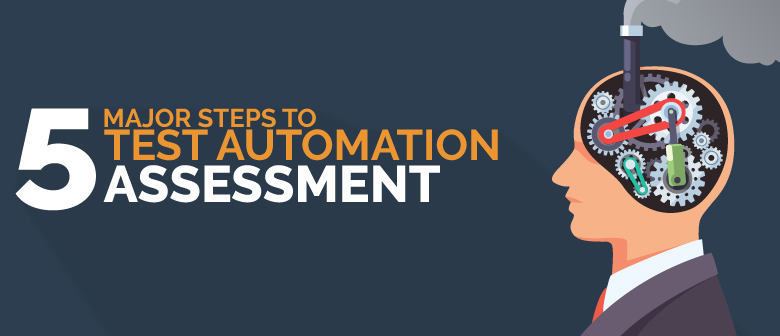
5 Major Steps to Test Automation Assessment
October 6th, 2017

Gone are the days when the companies used to hire several employees to conduct manual testing on its products. A majority of companies these days rely on the invaluable process of test automation. Being a cost and time-saving process, it is important to make the best possible utilization of the process. In order to do so, it is important for the companies to assess the actual value of the process and try to obtain maximum benefit from the same.
 It is important to run these processes on an automation assessment tool so as to identify if there are any sort of loopholes present and fix them so that, the maximum benefit is obtained out of these. It is also beneficial to run these tests because it helps an organization determine whether it is ready to implement the test automation process or not.
It is important to run these processes on an automation assessment tool so as to identify if there are any sort of loopholes present and fix them so that, the maximum benefit is obtained out of these. It is also beneficial to run these tests because it helps an organization determine whether it is ready to implement the test automation process or not.
The key areas where this assessment focuses are automation framework in which reusable function libraries, test object maps, etc are detailed; integration in which test and defect managed is detailed; and the process’ fitment that includes details about existing/target automation coverage, test prioritization etc. in the software development life cycle (SDLC).
Test automation assessment can be implemented in five simple steps as mentioned below:
- Understanding the Existing System
At this stage, an understanding of the existing system, technology and processes is developed to check the present quality standards as well as testing processes that are followed. It is also good to develop a thorough understanding of the objectives, their technology stack, user flow as well as manual test cases if any.
- Assessment
A thorough assessment in terms of the tools usage and the extent to which they are ready to be automated is determined. This is done by preparing a requirement traceability matrix breakdown that contains the complete details of the extent of test cases, the exact business requirements, details of the exact functional requirements as well as the areas where there are chances of quality improvement.
Apart from these, the feasibility of a particular tool, its confirmation as well as an analysis report on automation ROI (return on investment) is also done. Some of the most business-critical test cases are also identified at this step.
- Conduct a Proof of Concept (POC)
The POC is implemented to identify the type of test cases that are feasible for a particular product. In other words, it includes the process in which a few selected test cases are implemented to conduct POC and determining the exact need of a complete automation.
- Recommendation & Implementation
On the basis of these tests and their results, necessary recommendations are made so as to improve the product quality, its performance and deliverability.
- Implementation
The recommendations made are, then, implemented at this stage. Apart from this, certain specific test automation tools, feasibility, and its approach is also defined clearly at this stage. The best and appropriate automation strategies are executed at this stage so that it helps in enhancing the testing quality as well as reducing the required testing effort and time.

The outcome of a perfect test automation assessment process comes from following the right automation strategy and helps in enhancing test quality, reduce testing efforts, on-time delivery and get return in investments. Assessing test automation is not only beneficial in terms of improving the testing process but it is also advantageous for the companies, who plan to deliver the best and most advanced products to the market.


 Software Testing Events
Software Testing Events App Testing
App Testing Web App Testing
Web App Testing Game Testing
Game Testing Automation Testing
Automation Testing Load Testing
Load Testing Security Testing
Security Testing Performance Testing
Performance Testing Hire a Tester
Hire a Tester





